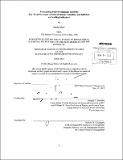Forecasting future economic growth : the term structure of interest rates, volatility and inflation as leading indicators
Author(s)
Khait, Maria
DownloadFull printable version (3.147Mb)
Other Contributors
Sloan School of Management.
Advisor
Douglas T. Breeden.
Terms of use
Metadata
Show full item recordAbstract
The broad literature documents the empirical regularity that slope of the term structure of interest rates is a reliable predictor of future real economic activity. Steeper slopes presage increasing growth, and downward sloping term structures presage declining growth or even recession. Some instances of slope's misleading signals were recorded in 2006 (the term structure was flat, indicating decline in economic activity when high growth continued) and 2008 (the term structure was very steep, predicting economic growth when recession continued and took a deep dive). Moreover, Breeden (2012a) showed that the term structure of interest rates has had less predictive power over the past fifty years than has been found in earlier researches over shorter periods of time. The key idea underlying this paper was to test whether the term structure of volatility and the term structure of inflation combined with the term spread could improve predictions of future economic growth compared to interest rate based forecasts with only one variable. This study finds that while the term structure spread and volatility appear to be statistically significant variables there is little evidence of improved performance compare to interest rate based forecasts with only one variable.
Description
Thesis (S.M.)--Massachusetts Institute of Technology, Sloan School of Management, 2012. Cataloged from PDF version of thesis.. Includes bibliographical references (p. 51-52).
Date issued
2012Department
Sloan School of ManagementPublisher
Massachusetts Institute of Technology
Keywords
Sloan School of Management.